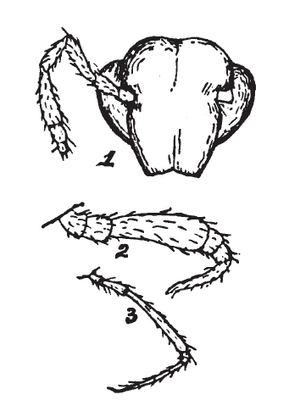Trichopetalum whitei facts for kids
The Luray Caverns blind cave millipede (scientific name: Trichopetalum whitei) is a very special and rare millipede. It lives only in caves, which means it's a "troglobite." This millipede is found in the upper Potomac River area, across four counties in Virginia and three counties in West Virginia. It was first discovered in the famous Luray Caverns.
Quick facts for kids Trichopetalum whitei |
|
|---|---|
 |
|
| Head (1), enlarged 6th leg (2), and normal leg (3) of a male T. whitei | |
| Conservation status | |
| Scientific classification | |
| Kingdom: | |
| Phylum: | |
| Subphylum: | |
| Class: | |
| Order: |
Chordeumatida
|
| Family: |
Trichopetalidae
|
| Genus: |
Trichopetalum
|
| Species: |
T. whitei
|
| Binomial name | |
| Trichopetalum whitei (Ryder, 1881)
|
|
| Synonyms | |
|
Zygonopus whitei |
|
Contents
What Does It Look Like?
The Luray Caverns blind cave millipede is unique! It's completely eyeless, so it can't see anything. It's also white because it lives in darkness and doesn't need skin color for protection from the sun.
Like other millipedes in its family, it has rows of very long, thin hairs called setae along its back. To tell this millipede apart from others, scientists need to look at it very closely under a microscope. They also study its special body parts used for mating.
Where Does It Live and What Does It Eat?
Cave Dweller
This millipede is a true "troglobite," meaning it can only live in caves. It especially likes damp, rotting wood inside the caves.
What's for Dinner?
Scientists believe T. whitei is an omnivore, meaning it eats both plants and animals. However, no one knows exactly what its favorite foods are. It likely picks up tiny bits of food from the cave floor or scrapes material off surfaces using its mouthparts. Then, it grinds the food with its mandibles (jaw-like parts).
Its Home Range
You can find this millipede in caves within the upper Potomac River area. This includes Augusta, Page, Rockingham, and Shenandoah Counties in Virginia. It also lives in Hardy, Grant, and Pendleton Counties in West Virginia.
Some scientists think another cave millipede, T. weyeriensis, might be the same species as T. whitei. If this is true, then the Luray Caverns blind cave millipede's home range would also stretch into Greenbrier, Monroe, and Pocahontas Counties in West Virginia.
Reproduction and Life Cycle
Scientists don't know much about the life cycle of the Luray Caverns blind cave millipede. However, they have studied similar millipede species.
In related species, the male millipede makes a special package of sperm called a spermatophore. He then transfers this package to the female during mating. This is how they reproduce and create new millipedes.
Protecting This Rare Millipede
Conservation Status
The Luray Caverns blind cave millipede is considered "globally vulnerable" by NatureServe. This means it's at risk of extinction around the world. Populations in West Virginia are "critically imperiled," which is a very serious level of risk. Virginia populations are considered "imperiled."
Special Protection
Because it's so rare, T. whitei is listed as a "Regional Forester Sensitive Species." This means it gets special protection in the Monongahela National Forest in the Eastern Region of the Forest Service. This helps make sure its cave homes are protected.
How It Got Its Name
T. whitei was first described by a scientist named Ryder in 1881. He originally named it Zygonopus whitei. Later, in 1972, another scientist named Shear changed its name to Trichopetalum whitei. This happened when scientists realized that Zygonopus was actually the same as Trichopetalum.
Some scientists, like Causey, have even suggested that Trichopetalum weyeriensis might just be a type of Trichopetalum whitei, rather than a completely different species.


